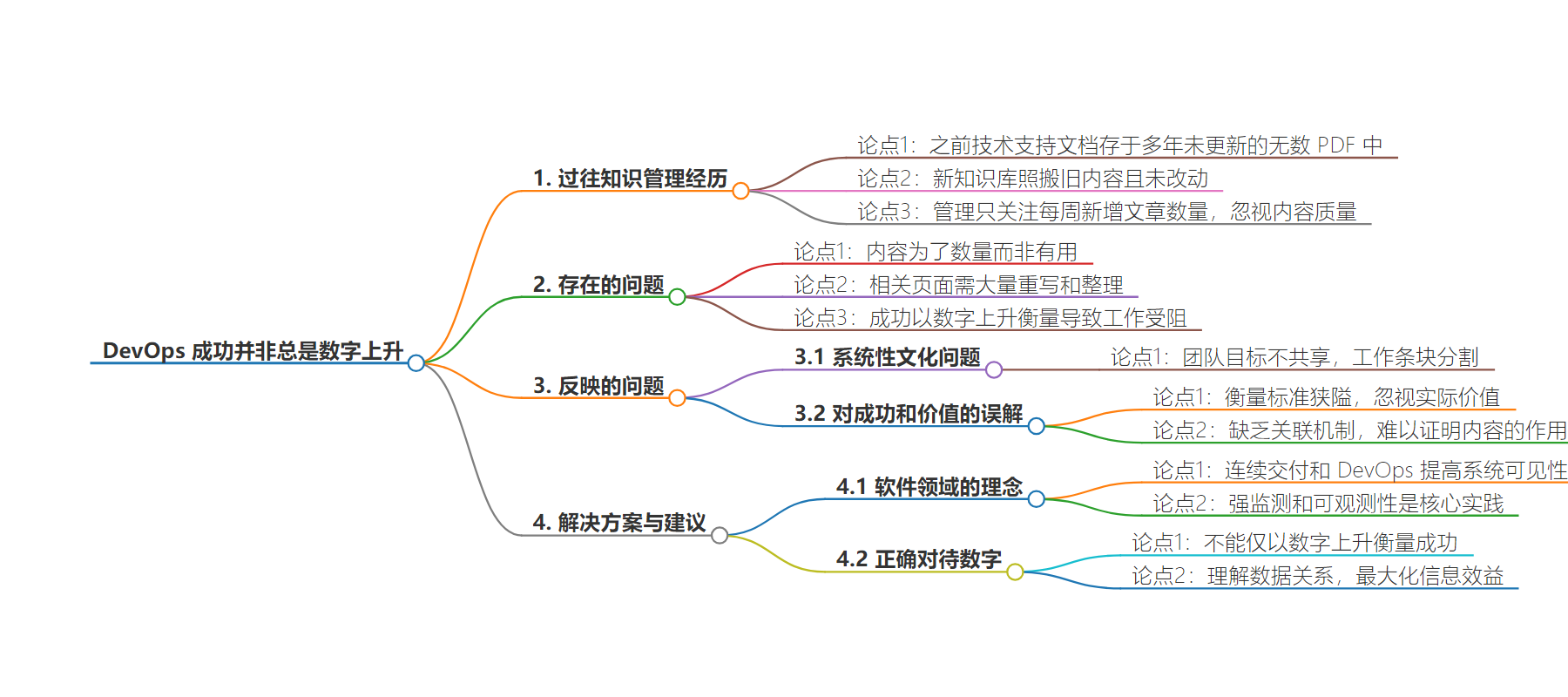包阅导读总结
1. 关键词:DevOps、知识管理、成功衡量、数字增长、内容价值
2. 总结:文章通过作者在知识管理工作中的经历,指出仅以数字增长衡量成功的弊端,强调应关注内容价值和关系影响,以DevOps为例说明全面理解数据关系的重要性。
3. 主要内容:
– 作者曾在知识管理领域工作,此前组织的技术支持文档存在诸多问题。
– 新成立团队讨论成功标准,管理者仅关注每周新增文章数量,而忽视内容质量。
– 为使知识库有用,应重写、合并和删除部分内容,但这与管理者“数字必须增长”的观念冲突。
– 这种以数字增长衡量成功的做法反映了系统性文化问题和目标不一致的弊端。
– 以DevOps为例,强调应通过强大的监测和可观测性理解数据关系,不能仅看数字增长,要关注全面价值。
思维导图:
文章地址:https://thenewstack.io/devops-success-isnt-always-numbers-going-up/
文章来源:thenewstack.io
作者:Andy Corrigan
发布时间:2024/8/5 17:58
语言:英文
总字数:828字
预计阅读时间:4分钟
评分:90分
标签:DevOps,知识管理,指标,软件开发,持续交付
以下为原文内容
本内容来源于用户推荐转载,旨在分享知识与观点,如有侵权请联系删除 联系邮箱 media@ilingban.com
Story time! In a past life, I worked briefly in knowledge management. There I maintained the content the organization hoped would help internal customers help themselves.
The organization never had a proper knowledge base before, previously storing all technical support documentation in countless PDFs that hadn’t seen updates in years. Just before I started, all that content — outdated and in many cases useless — was copied and pasted, unchanged, into the new knowledge base.
The horror.
But that wasn’t the only terrifying experience in those first few days. Further jump scares would come in a meeting with management, where we discussed what success would look like for our small, newly formed team.
“How long does it take to write a knowledge article?” was the first chilling question, as if “one article” could be a quantifiable measurement. Web pages differ in length, of course, and the time needed for each page depends on the subject’s depth or complexity.
The real horror set in, however, when I realized the manager’s only vision of success for the new knowledge base was how many articles we could add per week.
Content for the sake of content is rarely useful, but to reiterate, our starting point was over a decade’s worth of old PDFs uncritically pasted into a system unsuited for the format.
The pages that were still relevant needed hefty rewrites because they could not be found in search or were not written with accessibility in mind. Many weren’t suited for a nontechnical audience, which was, bluntly, almost our entire audience.
To make the knowledge base useful at all, much of our work would involve reducing the amount of content through rewrites, merges and by deleting pages no longer relevant.
The reality that success could actually mean reducing page numbers broke brains because “numbers must go up” was the only metric that made sense to those I was reporting to. More is always better; everyone knows that!

Due to that mentality, I was often discouraged from making content useful, which meant people wouldn’t always get the help they needed even if they could find it.
So, if help content isn’t findable or understandable … why even have a knowledge base?
But, hey, for those reporting upward, everything was all dandy: “My team is performing because, look, numbers go up!”
Some of these conflicts point to a systemic culture problem that highlights how badly things can get compartmentalized when teams don’t share goals. More importantly, it also shows how easy it is to lose sight of what success and value actually are when your ideas for both are so few, narrow and isolated.
In this anecdotal case, there was no way to prove the obvious — that the same information but easier to read and find could lighten the load for other support areas — because there was no mechanism to draw the correlation. Information sources that might’ve allowed us to find connections between content and customer behavior were, bizarrely, kept at arm’s length.
The lesson here is that by focusing so much on “numbers go up” without understanding what those numbers mean in the broader context, it’s easy to miss the relational effects that measured activities can have on one another. You only obscure areas where you might find new benefits.
Thankfully, for those of us in the software development space, ideologies like continuous delivery and DevOps help you build this visibility into your system. Strong monitoring and observability are core recommended practices in both.
As per the Octopus white paper “The Importance of Continuous Delivery,” for example, continuous delivery recommends not only tracking every data source, but doing so in one system so you can see relationships not otherwise obvious. It also suggests tracking business metrics in the same system as your technical metrics to see when a technical change has a negative or positive impact on business or vice versa.
Crunching the Numbers (Derogatory)
Look, I understand it’s natural in business that some numbers must go up. Organizations want to see profit margins rise, of course. Likewise, software teams adopting DevOps should strive for more commits, builds and deployments because those are proven predictors of organizational success.
However, to use “numbers going up” as your only measurement for success across all tasks is to deny yourself complete understanding of what value means across your business. Sometimes it’s smarter to do less in one area so you can do more elsewhere, and you won’t find the balance or spot where you need to adjust if you build walls between your information.
Only by maximizing the benefits of available information can you make those calls with confidence. Context is king, and it’s context you’ll miss if you don’t understand relationships in your data.
YOUTUBE.COM/THENEWSTACK
Tech moves fast, don’t miss an episode. Subscribe to our YouTubechannel to stream all our podcasts, interviews, demos, and more.
